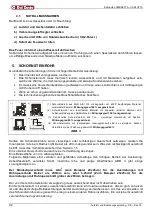
Chimney stove
OMBRETTA - CARLOTTA
24
Instructions for installation and use – EN – Rev.05
The wood used as fuel must have a moisture contents lower than 20 %, which is obtained after at least 1
year drying (tender wood) or 2 years (hard wood) and must be stored in a dry and ventilated place (for ex.
Under a shed). The wet wood makes ignition more difficult because it is necessary a greater quantity of
energy to evaporate the existing water. The humid contents has the disadvantage that, with the
temperature lowering, the water condensates first in the hearth and then in the chimney. The unseasoned
wood contains about 60 % of H20, then it is not suitable to be burnt. The following cannot be burnt:
rests of coal, cut-offs, parts of barks and panels, wet wood or treated with varnished, plastic
materials. In this case the guarantee on the appliance lapses. Paper and carton must be used only
for ignition.
The combustion of wastes is forbidden by national law on the protection against emissions. This
may damage the stove and the chimney, causing health damages and claims by the neighbourhood owing
to the bad smell.
The wood is not a fuel which allows a continuous operation of the appliance, as consequence the heating
all over the night is not possible.
ATTENTION: the continuous and protracted use of aromatic wood (eucalyptus, myrtle etc.) quickly
damages the cast iron parts (cleavage) of the product.
9. LIGHTING
IMPORTANT: The first time that the appliance is lit, there will be an odour given off (due to the drying of
the adhesives of the junction chord), which disappears after a short use. It must be ensured, in any
case, a good ventilation of the environment. Upon the first ignition we suggest loading a reduced
quantity of fuel and slightly increasing the calorific value of the equipment.
To perform a correct first lighting of the products treated with paints for high temperature, it is necessary to
know the following information:
•
the construction materials of the involved products are not homogeneous, as matter of fact there
are simultaneously parts in cast iron, steel, refractory material and majolica;
•
the temperature to which the body of the product is subject is not homogeneous: from area to area,
variable temperatures within the range of 300°C - 5 00 °C are detected;
•
during its life, the product is subject to alternated lighting and extinguishing cycles in the same day,
as well as to cycles of intense use or of absolute standstill when season changes;
•
the new appliance, before being considered seasoned has to be subject to many start cycles to
allow all materials and paints to complete the various elastic stresses;
•
in detail, initially it is possible to remark the emission of smells typical of metals subject to great
thermal stress, as well as of wet paint. This paint, although during the manufacture it is backed at
250 °C for some hours, must exceed many times and f or a given period of time the temperature of
350 °C before becoming completely embedded in the m etallic surfaces.
Therefore, it is extremely relevant to take these easy steps during the lighting:
1) Make sure that a strong air change is assured in the room where the appliance is installed.
2) During the first starts, do not load excessively the combustion chamber (about half the quantity
indicated in the instructions manual) and keep the product continuously ON for at least 6-10 hours
with the registers less open than the value indicated in the instructions manual.
3) Repeat this operation for at least 4-5 or more times, according to your possibilities.
4) Then load more and more fuel (following in any case the provisions contained in the installation
booklet concerning maximum load) and, if possible, keep the lighting periods long avoiding, at least
in this initial phase, short ON/OFF cycles.
5) During the first starts, no object should be leaned on the appliance and in detail on
enamelled surfaces. Enamelled surfaces must not be touched during heating.
6)
Once the «break-in» has been completed, it is possible to use the product as the motor of a car,
avoiding abrupt heating with excessive loads.
To light the fire, it is suggested using small wood pieces together with paper or other traded lighting means.
It is forbidden to use any liquid substance as for ex. alcohol, gasoline, oil and similar.
















































